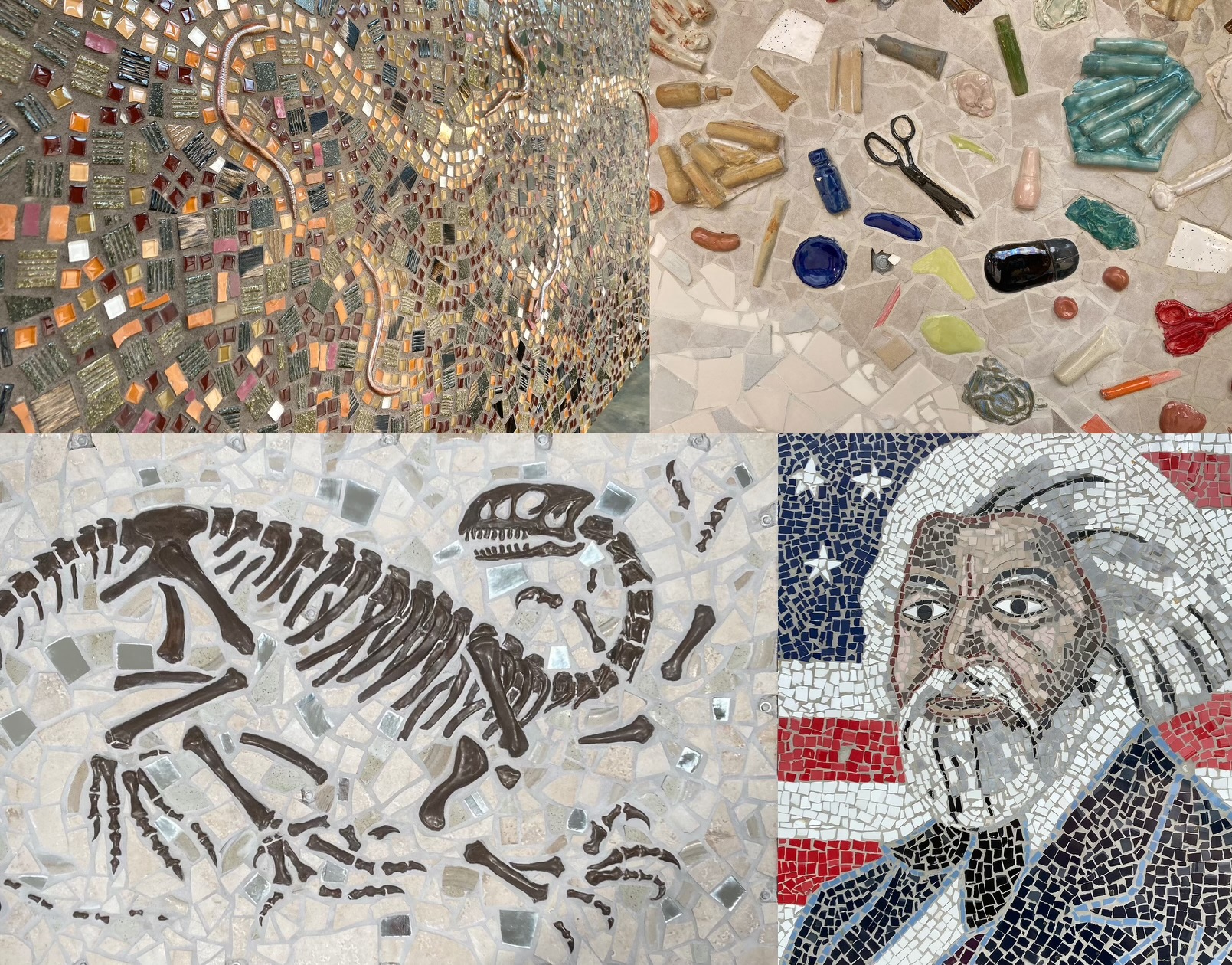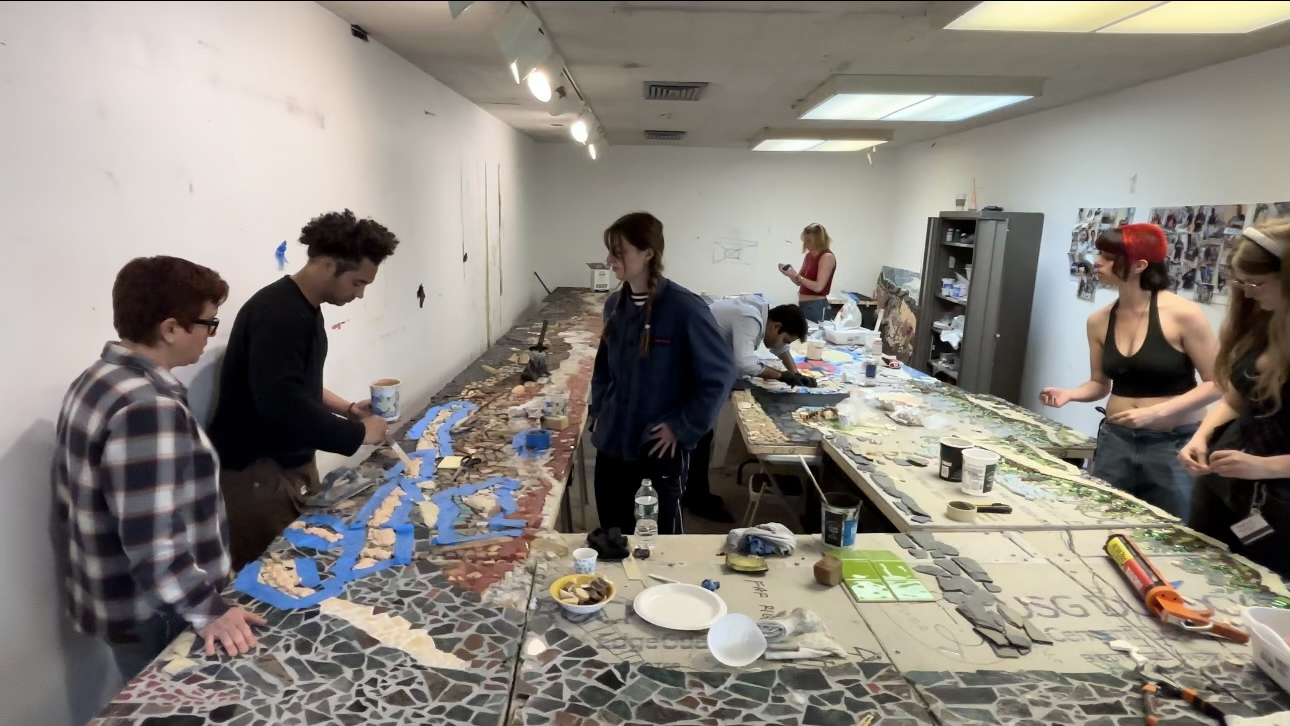
c/o Middletown Press
Last Thursday, May 2, the Tunnel Vision project entitled “Mosaics on Main Street” was publicly launched through an opening ceremony led by Adjunct Assistant Professor of Art Kate TenEyck, the project’s founder. The event included fellow artists from Middletown and members of the University community.
“It was amazing to see the Middletown [and the] Wesleyan community come together,” Maya Alicki ’24 said. “Thanks to Kate, who likes to bridge the gap between Middletown and Wesleyan, I’m excited to see [the mosaic] when all the pieces are done and installed.”
TenEyck came up with the idea at the end of October 2022, initiating the project shortly after. A Middletown local, TenEyck sought to highlight the rich history of her city in a location important to the community’s evolution. The footpath under Route 9 leading to Harbor Park was the perfect site for this project.
“We have this beautiful park, but to get there, you have to go through this ugly tunnel, which is poorly lit and has graffiti,” TenEyck said. “So I thought, this is kind of like an archaeological dig. We’re going down, on this ramp and stairs going underground. What if we looked at the history of Middletown through the lens of an archaeological dig? I think it’s reflective of the space so much. It just directly reflects the descent both into history and physically into the ground. It’s so site-specific.”
After visiting her daughter in Austin, Texas, TenEyck felt inspired by a mural displayed at a local pool and wanted to do something similar in her own hometown.
“It was seeing this documentary on the Deep Eddy Pool [in Austin, Texas]…that made me think I could do it [in Middletown],” TenEyck said. “[The mosaic] was huge and I could tell that community members had contributed.”
Inspired by other displays of public art, including the work of American mosaic artist Isaiah Zagar, who has made over two hundred installations in Philadelphia, TenEyck became interested in the possibilities of mosaic as an art form that could bring together the community while displaying the vast historical record of Middletown.
“I [wanted to go] for something that [could] use found [materials] and [involve] community members,” TenEyck said. “This is not a New York City subway [piece] where an artist comes up with a design and they send it to some fancy workshop and then they make it and they install it and it looks beautiful, but it has no character.”
TenEyck’s goal of utilizing found materials motivated her to source materials directly from her community in an environmentally friendly and financially conscious manner.
“I went around and asked everybody for tiles,” TenEyck said. “Some artists were able to incorporate donated tiles more than others. I’ve already carried thousands of pounds of tile from people’s garages and basements, so that is a really cool way of reusing material from the area.”
To get started on her project, TenEyck applied for funding immediately, securing an American Rescue Plan Act (ARPA) grant from the downtown business district to display local artwork in empty storefronts on Main Street.
“They were like, we love your project,” TenEyck said. “What if you make the mosaics and we put them in the windows and then eventually they go down to the tunnel?”
Displaying each piece of the mural individually will allow for TenEyck to highlight the many artists, community members, and students she has collaborated with to make the project possible.
“I feel like [the Wesleyan and Middletown community] have a lot to give each other and it can be a struggle sometimes to build that bridge or forge that tunnel,” TenEyck said.
TenEyck has been collaborating with members of each community to depict the metamorphic journey of delving deeply into both the Earth and the passage of time throughout history. By collaborating with Middletown artist and founder of Artists for World Peace Wendy Black-Nasta, who has worked closely with the Wangunk tribe to highlight their historical and current presence in Middletown, TenEyck hopes to depict previously overlooked indigenous history.
“[We have been referring to objects] that were found locally made thousands of years ago by people who lived here,” TenEyck said. “We chose several of them and they were 3D printed [to make] molds [which] fourth graders from Middletown Public Schools [used]… to make tiles that are now being embedded.”
Additionally, TenEyck has collaborated with local mosaic artist Pierre Sylvan, whose work depicts Black Middletown history, Assistant Professor of Art Ilana Harris-Babou, who utilizes everyday objects in her work, and scientist and artist Dr. Kat Owens, who combines science, policy, and the arts in her work.
“I asked [Professor Harris-Babou] to do this piece about what she calls ‘How Will We Be Remembered?’” TenEyck said. “Then there is a tiny section of the piece that Kat Owens made, who’s a scientist and an artist…about worms and grubs.”
Going deeper into the layers of Middletown history, TenEyck’s own work deals with deep time.
“Deep in the tunnel would be 200 million years ago,” TenEyck said. “That’s when dinosaurs [like the ankylosaurus] were walking around. [My piece] which I sculpted is based on fossils [and pictures] that I found. Just 22,000 years ago, Connecticut was under a mile of ice, so a glacier piece is going to be in there. And then I want to do stuff about plate tectonics and lava flows.”
In constructing the project, TenEyck involved students from her class this semester entitled “Community-Based Public Art: Mosaics on Main.” Students spent the semester working with TenEyck to put together the mosaic while collaborating with members of the Middletown community to amplify their history.
“The most satisfying [part of the project] has been seeing [it] evolve,” said Matty Shields ’25, a student in TenEyck’s class who will be continuing to work with her on the project this summer. “It’s been a really cool process of, you know, how do we know [if] we have the right amount of space? What do we want to highlight? And we know it’s going to be about Middletown, but what is it going to look like?”

c/o Matty Shields
Aisha Odetunde ’25, another student in the class, pointed out how the project’s value differs from her previous experiences with art in class and at private institutions, emphasizing its real-world implications.
“I am interested to see how art is seen within a public setting because I guess I’m always seeing art pieces in the gallery,” Odetunde noted. “There’s a time limit. There’s a budget limit. We’re taking into consideration the people who are part of the community of Middletown, so there’s a whole extra layer to it that feels real.”
Students in the class conducted oral histories with locals who unveiled their experiences growing up in the city, an aspect of the project that TenEyck described as an important part of its evolution.
“We [got] to interview a bunch of individuals living in senior residential homes around Middletown,” Coco Brooks ’24, who is another student in the class, said. “We [spoke to] people who have lived here their whole lives and that was super rewarding and very special. I definitely see Middletown in a different way.”
In addition to gathering information from Middletown Residents, students actively contributed to Black-Nasta’s 268-square-foot wall section depicting the indigenous history of Connecticut.
“The thing that upsets me is there’s no mention of the Native American community in Middletown anywhere,” Black-Nasta said. “I [wanted] to do an honor wall [dedicated] to the First Nation of Connecticut. [This part of the] wall touches the ground because Native American spirituality has to do with the Earth Mother.”
The class has been pivotal in reaching this objective, with Black-Nasta highlighting how each student contributed their distinct skills to the extensive project.
“I love their energy and I love the fact that I could teach them about Native culture,” Black-Nasta said.
In collaboration with fourth graders from Middletown public schools, Black-Nasta and the students of Mosaics on Main replicated artifacts found in and around Middletown and kept in the Wesleyan Archaeology Department. These artifacts included axes and knives that were over 3,700 years old.
“First we 3D scanned, 3D printed, and made plaster molds,” Black-Nasta said. “Then the fourth graders came and filled the molds and recreated those artifacts. Then Gary [O’Neil] who is an elder of the Wangunk [tribe] and a potter [at Wesleyan Potters brought in] his seventh graders [who] rubbed oxide and fired them all.”
Black-Nasta further collaborated with O’Neil in portraying the history of the Wangunk in Middletown by making use of his own work as a potter.
“Garry made us traditional Wangunk pots, glazed them, [and they were broken] into shards,” Black-Nasta said. “[These shards] were put in the wall.”
Ultimately, Black-Nasta aims to honor the diverse indigenous communities of Connecticut through an opening ceremony that unites the state’s tribes.
“I want to bring the Eastern Pequot, the Western Pequot, the Wangunk, and the Narragansett to come drum, sing, and bless the wall and bless Middletown,” Black-Nasta said. “I want our community to see that Native Americans are here. They’re strong. They’ve survived. You know, I want people to understand the land that they’re on. So in addition to celebrating, I also would like some of the tribal elders to speak, so that people in our community learn the history of our community.”
Overall, more than four hundred people, including the fourth graders from Middletown public schools, will have contributed to the project. While the project is nowhere near finished, TenEyck’s network of support will continue to move the project forward into the future.
“[Mosaic is] almost like a metaphor for life where, you know, you might have a big project and then you just do one thing at a time and then you look backwards [and] you’re like, how did I do that? And it’s that one little piece at a time,” TenEyck said.
Jo Harkless can be reached at jharkless@wesleyan.edu
Dove Bonjean-Alpart can be reached at dbonjeanalpa@wesleyan.edu
Correction note: The original version of this article incorrectly stated that the artifacts that this group is replicating were over 37,000 years old. They are over 3,700 years old. The article has been edited to reflect this change.